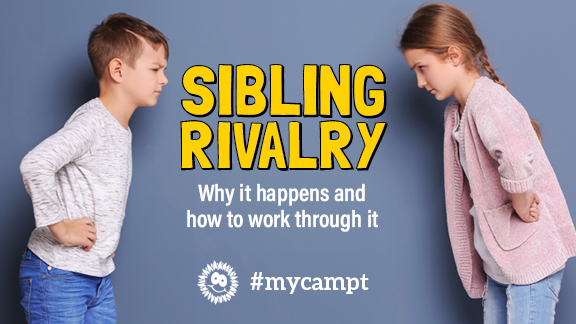Sibling rivalries have been a part of family life since the beginning of time. Sometimes they’re harmless, but they can often contribute to a negative relationship between your children. To help you navigate and help to resolve the problems those bickering children are having, here are a few reasons why those siblings squabble and a few positive parenting tips to constructively work through and find solutions to their issues. The information and techniques were shared by parenting experts at EmpoweringParents.com, Kids Health, and the Center for Parenting Education, including Debbie Pincus, a licensed mental health counselor with a Masters of Sciences, and Jennifer S. Pendley, PhD, a pediatric behavioural health practitioner.
Why they Bicker: The Blame Game
Playing the blame game is a common issue that we as parents often wrongly fall into when trying to resolve a sibling dispute. Looking for someone to blame for a fight isn’t constructive and could engender an unintended feeling of preferential treatment from one of your children. We as parents should especially not try to referee a fight if we don’t know what happened. In the end, it takes two to tango, so both parties involved are partially responsible.
Why they Bicker: Evolving Needs
It’s more than likely that your children are of different ages, which means they are at different stages of their growth as young people; this will inevitably affect the way in which they interact with each other. As we’re sure you can attest, toddlers need to possess things and aren’t big on sharing. School-age children have a strong sense of fairness and equality, which could make them angry when they don’t understand why a sibling is being treated differently. High-school age teens are looking for more independence, and may resent having to take care of younger siblings or help with household chores those siblings can’t complete, which can also contribute to sibling rivalries.
Why they Bicker: Different Temperaments
Every kid is unique and different from the others. They have distinctive temperaments, moods, personalities, and interests which means they must be treated differently at times and this can sometimes cause siblings to feel frustrated with one another. For example a more frenetic and emotionally sensitive sibling could cause friction and become angry with a more calm one because the latter doesn’t want to be ‘bugged’ and would rather spend time alone instead of with their siblings. This is why it’s important for you to make it clear that the basis for decisions is not equality but, need. Fair does not mean equal; it means each person getting what they need.
Why they Bicker: Parental Role Models
Children pick up a lot from their parents – we are their first and most important role models – and when they get into disputes with their siblings, they could be mimicking behaviour they see from them. If you show your children that you work through arguments in a calm and respectful manner, it will rub off on the relationships your children have with each other. On the other hand, if you can’t control your temper and you’re seen shouting and arguing aggressively, your youngsters will likely follow suit.
Now that you know some reasons why your children argue, you can try some of these tried and tested techniques to help you play peacemaker and resolve the issues through positive parenting.
Techniques for Resolution: Set Ground Rules in Advance
One of the most important things a parent can do to avoid intra-family disputes is to set up a clear set of ground rules for everyone to keep in mind whenever they feel themselves getting heated. These rules should be revisited every year, possibly on a designated day in the month before school or another time the family finds effective. The rules also help to instill the values you feel are important for your family to have. Examples could include, but are not limited to, things like: treat everyone in the house with kindness and respect, no hitting under any circumstances, don’t take someone’s things without asking first, no yelling or name-calling etc. Take the siblings’ input on these rules, as well as the consequences if they’re broken. By doing this, children learn that they are responsible for their own actions regardless of whether they felt they were provoked or not.
Techniques for Resolution: Separate Them To Cool Off
Emotions clearly play a major role in most conflicts, and when emotions are running high it is very hard to come to a reasonable solution. Taking a break is sometimes best to give each kid some space. If you try to take the shortcut and rehash the problem immediately to get a quick solve, it could easily backfire and instead re-escalate the argument. If you want to make conflict resolution a learning experience for your children, its best to separate bickering siblings until their emotions have died down and they’ve had time to cool off.
Techniques for Resolution: Green Light to Red Light Guideline
One of the toughest questions to answer in this sibling rivalry equation is when the proper time is for you to jump into the fight and play peacemaker. The Center for Parenting Education’s Green Light to Red Light Guideline is a great tool to use to help you decide when and how to intervene in a sibling rivalry:
- We start with the green light, normal bickering that we should steer clear of.
- Next comes the yellow light, when the argument starts to heat up slightly and we need to step in, acknowledge the anger, and reflect on all viewpoints.
- When we get to the orange light, the situation has become more serious and the question, ‘is this play or real?’ must be asked before firmly stopping the interaction, reminding them of the ground rules and helping with the conflict resolution if necessary.
- Ideally, we know the orange light when we see it and can avoid the dreaded red light, but if for some reason you get to the red light, and physical or emotional harm is about to or has already occurred, you must firmly stop and separate the children. If someone’s hurt, attend to that child first before reviewing the rules and imposing a consequence you agreed on when laying down the ground rules.
Techniques for Resolution: Cooperative Conflict Resolution
Trying to get the children to cooperate with one another to find a solution after some time apart to cool off is always a positive step. If you came late to the party, the ‘notepad, one pencil, one story,’ technique could be of use. You give the bickering pair of children one notepad and one pencil and they have to work together to write down what happened. By getting the siblings to work together to give you a story they can both live with, it helps them to see and begin to understand the other person’s perspective. Another great tool is the ‘sit and permission to get up’ approach. WIth this technique they can both get up as soon as they give each other permission to do so. An apology is not the end goal here, but rather cooperation. It’s wonderfully simple and makes the siblings fully interdependent, which helps them to work together towards their common goal.
Techniques for Resolution: Make Time for Family Activities
Another great way to get them to stop fighting is to engage them in fun family activities together on a regular basis. This is not to say you should force siblings to be best friends, but doing something as a family can help build at least a positive relationship between your siblings. Family time that is peaceful and fun establishes a positive way for the children to spend time together and relate to one another. Not only does it bring them closer and ease any possible tensions, it also keeps you, the parent, involved at all times. If you’re having a fun time with all of your children together at once, it reduces the chances for arguments over parental attention as well which, as we all know, is a big one.
The amount of time they spend together and the close proximity with which they are forced to live with each other will inevitably lead to some squabbles for your youngsters. The fact that they’re family also means the sibling relationship is one of the safest for children, which means they think they can push the boundaries and argue with fewer repercussions. Sometimes arguments and fights can help children build important skills such as compromise, standing up for your position, resolving differences and seeing other people’s perspective, which is why it’s important for parents to reflect on when to get involved, and when to let children live through the experience. What we as parents want to do is limit the negative consequences of these natural rivalries. If you lay down clear rules the children must follow in the house, acknowledge all of the ways in which your youngsters are different and unique, and treat them accordingly while cultivating a fun and positive home life, you can consider yourself an elite referee in the parenting game!
Hope this helps make life more harmonious at home!
Let us know if you have other tried and true tricks you use in your own home by leaving a comment below!
Written by: Alex Murray
About Alex Murray: A recent graduate of Ryerson’s prestigious RTA Media program, Alex Murray is a passionate young writer with a variety of topic interests. He also spent four years as a camp counsellor for Camp Tournesol and has performed various other duties for the camp as it has grown over the years. A lifelong French immersion student from a French home, he is now a contributing blog writer for the Camp and serves as a Social Media Marketer for the team, among other freelance work. To learn more about Camp Tournesol visit www.campt.ca
Contact Alex Murray at [email protected] | 905-891-1889








